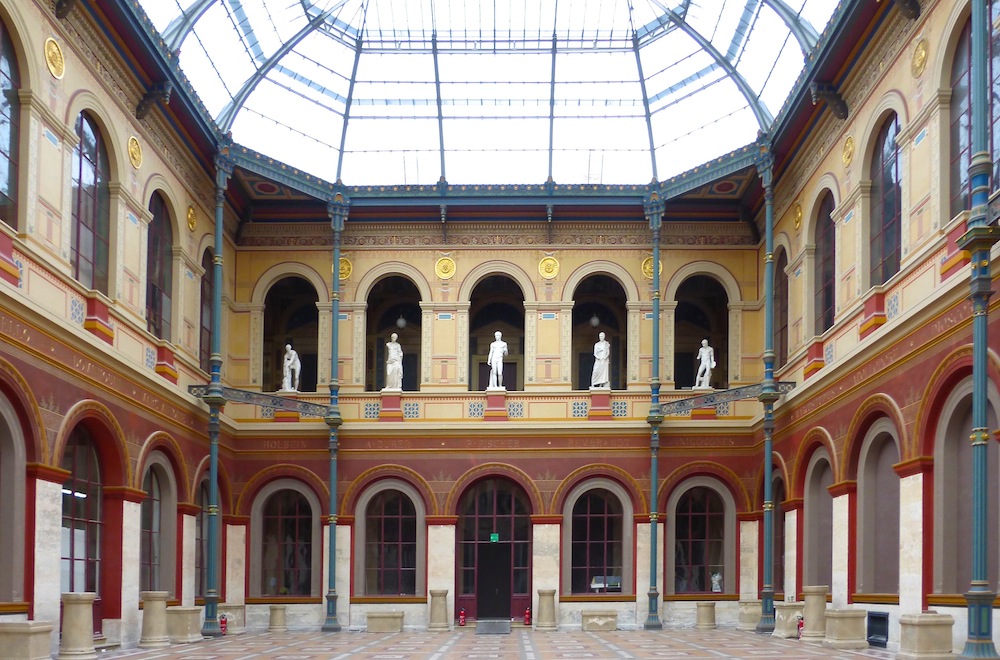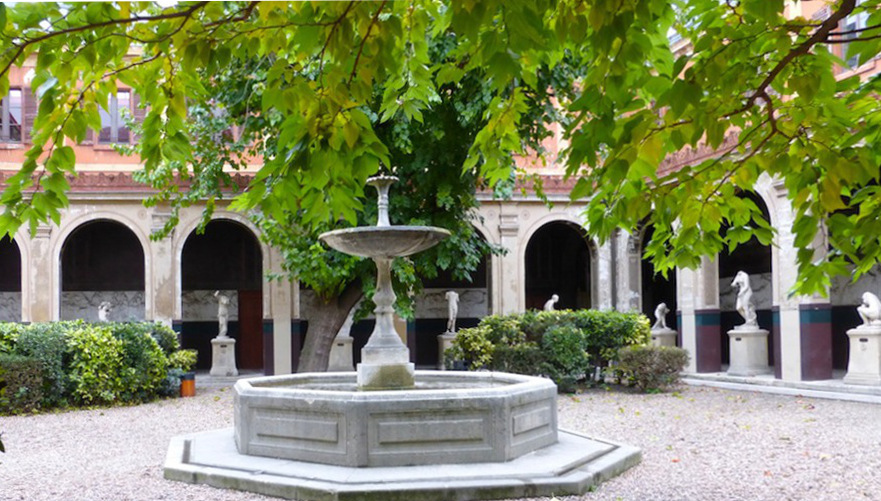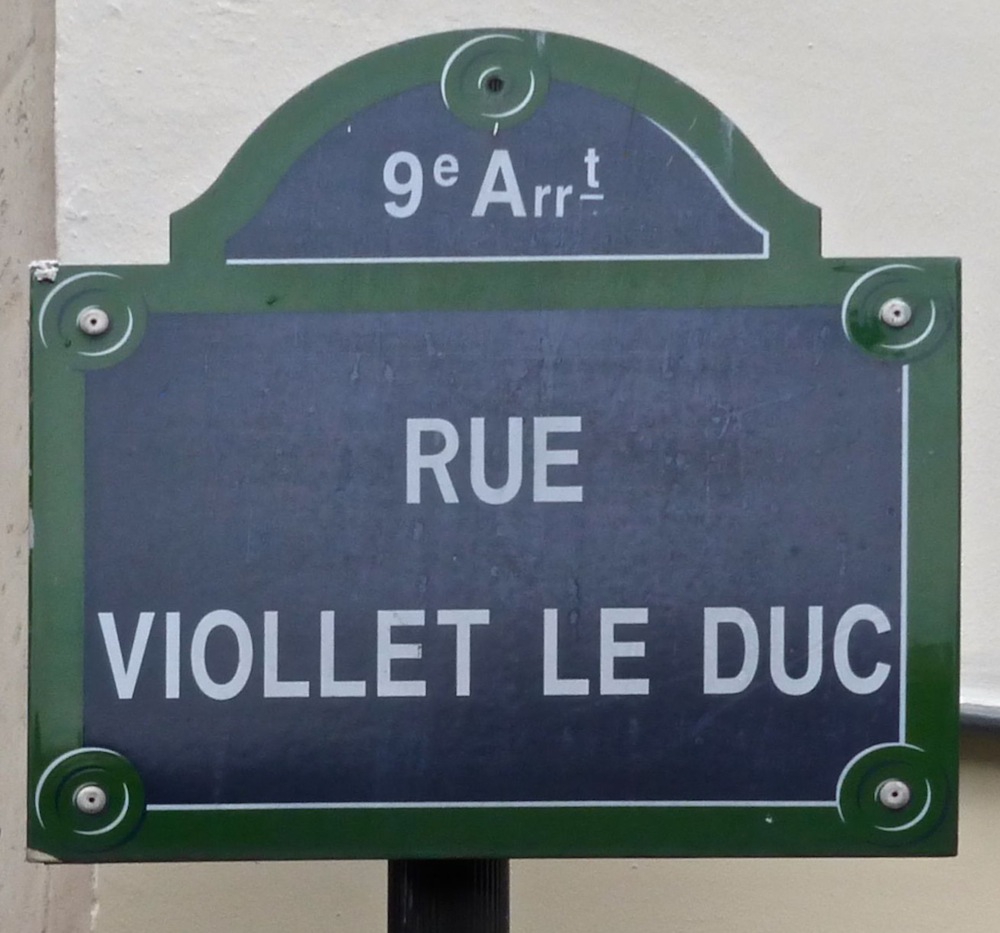
Eugène-Emmanuel Viollet-le-Duc (1814-79) was an important French Gothic Revival architect, responsible for some major restoration projects in France. He was also an architectural historian and theorist, who had a tremendous influence on the movement throughout Europe. He was, for example, a major source of inspiration for the Dutch Gothic Revivalist P. J. H. (Pierre) Cuypers, and the portrait of him on the right is displayed at the Cuypershuis in Roermond, in the Netherlands — where a similar portrait of A. W. N. Pugin hangs just beneath it. Pugin himself, and many other British architects, including Sir George Gilbert Scott, owed a considerable debt to this Frenchman.
Born in Paris, 27 January 1814, Viollet-le-Duc was the son of the "Conservateur des Bâtiments Royaux" (or Superintendent of the Royal Palaces) at the royal court. Perhaps not surprisingly, he took up a career in architecture. But he found himself completely out of tune with the main trends of his day. Instead of studying at the highly conservative École des Beaux-Arts in Paris, he started his training directly, first with the architect Jean-Jacques-Marie Huvé (1783-1852), and then with Achille-François-René Leclère (1785-1853). He also immersed himself a study of France's medieval buildings. Here he was greatly helped by the establishment of the Commission des Monuments Historiques, of which he became a member. As a young husband with a family, he took a job with the Conseil des Bâtiments Civils, and he did set up a practice, designing private houses, chateaux, churches and so forth. But he is far better known for his restorations, especially such major ones as those of La Sainte-Chapelle and the Cathedral of Notre Dame in Paris. The magnificently restored interior of the Upper Chapel of La Sainte-Chapelle is shown below right. He restored other churches and cathedrals, including the abbey churches of the Madeleine in Vézelay, St. Denis in Avignon, and the cathedrals of Amiens and Rheims.

Viollet-le-Duc's writings were even more important than his architectural work. Over his lifetime he produced over thirty influential volumes, illustrating them with engravings and wood cuts from his own highly detailed drawings. These publications included an account of the chapels of Notre Dame, as well as others about medieval castles. His interests spread beyond France, too: he traveled to Italy in 1836, visiting Rome, Sicily, Naples and Venice, and came to England in 1850 together with his friend, the writer Prosper Mérimée, who was also Inspecteur Général des Monuments Historiques in France. In 1854 he visited Germany as well. Among his writings, therefore, are a series of letters from Sicily, accounts of the ruins in Central America, and so on. He was awarded the gold medal of the RIBA in March 1864 (Bressani 307), and by the later 1860s the "great flood of translations" of his works was well under way (Reiff 34). Later in life, Viollet-le-Duc designed his own house in Lausanne, Switzerland, where he could escape from the pressures and disappointments of life in Paris.
His most important books were his Dictionnaire raisonné de l'architecture (1854) and Entretiens sur l'architecture et Dictionnaire du mobilier (1858). His works on domestic architecture in particular reached a popular audience. His last book, Histoire d'un dessinateur, comment on apprend à dessiner (1879) on the art of drawing, is considered "the broadest and most philosophical expression" of his views, and an educational classic (see Hearn 19). Demonstrating "remarkable singleness of purpose, independence of character, industry, and success" ("Eugene Emmanuel Viollet-le-Duc"), he inspired important architects all over Europe, not just Pugin and George Gilbert Scott in England. He had a similar impact in America too, for example on the young Frank Lloyd Wright. Martin Bressani has an interesting thesis that Viollet-le-Duc was driven throughout, in his need to reconnect with, revive and reconstitute the past, by "pathological mourning" (345) consequent on the early death of his mother. If so, this psychological pressure had extraordinarily far-reaching consequences.



Left to right: (a) The entrance to the École des Beaux-Arts, Paris, on the Left Bank, with its emphasis on classical ideals. Architect of the principal buildings: Félix Duban, who worked on the campus from 1830-61, and with whom Viollet-le-Duc himself worked at La Sainte-Chapelle. (b) The hall. (c) The inner courtyard. It is now called the École Nationale Superiore des Beaux-Arts.
Despite his interest in the past, Viollet-le-Duc was remarkably forward-looking. This "most fervent apostle of Gothic revivalism" was also a great advocate for the use of new materials, especially, rather later in his career, iron. This was bold, but it can also be connected with the idea of reconstitution: his object was simply "to demonstrate how Gothic builders would have made better use of industrial materials" (Bressani xxiv). Such a rationalist approach to restoration was as controversial as it was influential. As an educator, too, Viollet-le-Duc was innovative. He was for many years a Professor at the École Imperiale du Dessin, giving classes in ornamental drawing. Renamed the École des Arts Décoratifs, this school was later to become important in the Art Nouveau movement. However, Viollet-le-Duc failed to implement his ideas successfully at the classically-oriented École des Beaux-Arts, where he was briefly a Professor of the History of Art and Architecture. Unfortunately, this was just at the time when the pendulum was swinging away from the Gothic again. He duly resigned in 1863 and set up the École Spéciale d'Architecture with the civil engineer Émile Trélat — "preparing for its students, with his own hand, a series of examples for exercises in draughtsmanship, which have since been published, of unusual interest and great technical excellence" ("Eugene Emmanuel Viollet-le-Duc," 398).
By no means narrowly academic, Viollet-le-Duc had a tremendous amount of energy. For example, there is a wonderful description of him directing entertainments at the court of Louis Napoleon, where he arranged everything from the scenery and the costumes to the music; and another of him as lieutenant-colonel in the corps of civil engineers during the siege of Paris, working non-stop "walking stick in hand, directing the repair of the works as they were destroyed by the enemy's fire" ("Eugene Emmanuel Viollet-le-Duc," 388). However, having been actively engaged in it, he was bitterly disappointed by France's defeat in the Franco-Prussian War, as well as by the loss of many of his roles after the collapse of the Second Empire — although he did take part in local politics. He died suddenly and unexpectedly at the comparatively early age of 65.

Viollet-le-Duc's restorations have been criticised as too interventionist, because he actively adapted the past to suit his own notions of it, for example, adding gargoyles where none had been before. This was both recognised and criticised in his own times. William Burges's "final verdict on Viollet-le-Duc," says Joe Mordaunt Crook, was expressed publicly at the RIBA, and it was that "he was a great scholar, an average architect, and a disastrous restorationist." Crook adds: "Posterity has endorsed that verdict" (94). However, this street sign just to the south of Pigalle reminds us that he was popular enough at the time to have been elected councillor for the area in November 1874, and he is widely honoured now for his achievements. One of the twelve bronze apostles on the rooftop of Notre-Dame (Thomas, holding an architectural square) bears his likeness, although this was perhaps a memorial of his own devising (see "The Spire"). — Text and photographs by Jacqueline Banerjee; the picture at the top right was taken and is reproduced here with the kind permission of the Cuypershuis, Roermond, Netherlands.
Restorations
- La Sainte-Chapelle — exterior and stained glass (1841-67)
- Interior decorative elements at La Sainte-Chapelle
- The Cathedral of Notre Dame, Paris
Sources
Bressani, Martin. Architecture and the Historical Imagination: Eugène-Emmanuel Viollet-le-Duc, 1814-1879. Farnham, Surrey: Ashgate, 2014.
Crook, J. Mordaunt. William Burges and the High Victorian Dream. Revised ed. London: Frances Lincoln, 2013 [review].
"Eugene Emmanuel Viollet-le-Duc (May 1, 1879)." Jstor Early Journal Content. Proceedings of the American Academy of Arts and Sciences. Vol. 15. 394-99. Internet Archive. Web. 2 December 2014.
Hearn, M. F. "A Visionary among the Gargoyles." The Architectural Theory of Viollet-le-Duc: Readings and Commentary. Ed. M. F. Hearn. Cambridge, Mass.: MIT Press, 1990. 1-20.
Reiff, Daniel D. "Viollet-le-Duc and American 19th Century Architecture." Journal of Architectural Education. 4: 1 (Autumn, 1988): 32-47. Accessed via JSTOR. Web. 2 December 2014.
"The Spire." Cathédrale Notre Dame de Paris. Web. 2 December 2014.
"Viollet-le-Duc, Eugène [-Emmanuel]." Dictionary of Art Historians. Web. 2 December 2014.
Last modified 12 December 2014